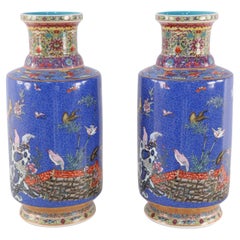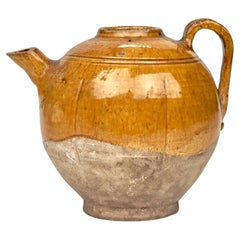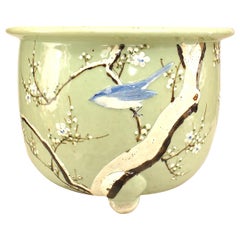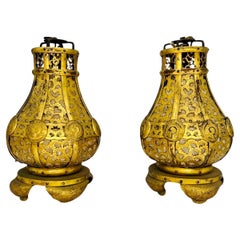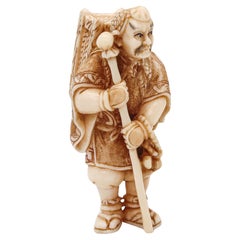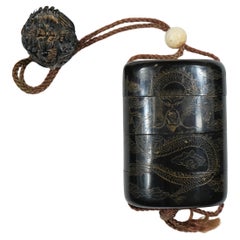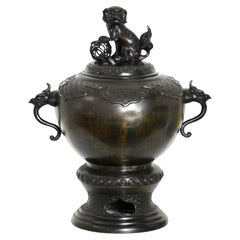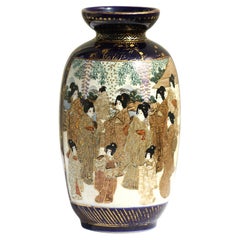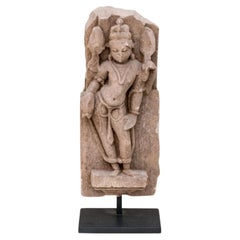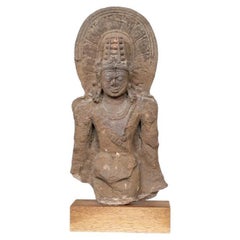Antiquities
102
1,943
10
3
to
435
803
448
1,956
1,953
1,953
8
7
5
4
3
3
2
1
1
1
1
1
1
1
836
591
516
13
237
72
50
38
4
13
6
6
18
10
6
16
3
626
524
458
268
196
1,694
1,191
829
321
313
10
4
4
3
3
Antiquities For Sale
JAPAN 1890 Meiji Polychromate Netsuke Of a Yamabushi Carved In Ivory
Located in Miami, FL
Japanese Meiji period netsuke. of a Yamabushi.
This is an exceedingly beautiful and intricate carved netsuke, created during the imperial Japan in the Meiji period, back in he 1890....
Category
1890s Japanese Meiji Antique Antiquities
Materials
Ivory
Japanese into with netsuke, late 19th c
Located in Stockholm, SE
A four part Japanese inro with a netsuke. The inro made of horn with engraved motives of dragons and clouds in gold over black. The netsuke is carved of boxwood and depicting a drago...
Category
Late 19th Century Japanese Antique Antiquities
Materials
Horn
A handsome antique Japanese bronze centerpiece
Located in West Palm Beach, FL
A handsome antique Japanese bronze centerpiece for an altar table in the form of a spherical covered urn with a dragon head handles, raised pedestals base, and expressive Shishi tem...
Category
19th Century Antique Antiquities
Materials
Bronze
Satsuma earthenware vase
Located in West Palm Beach, FL
Satsuma earthenware vase
the baluster-shaped body painted in enamels and gilt with two panels, one depicting numerous immortals with raised gilt in terraced garden setting, the othe...
Category
20th Century Antiquities
Materials
Ceramic
Ancient Indian Red Sandstone Carving Of An Apsaras
Located in Bridgeport, CT
A likely 12-14th Century Northern Indian temple fragment of a female figure or consort known as an Apsaras. Carved in Red Sandstone, the female figure is appropriately attired in bel...
Category
15th Century and Earlier Indian Agra Antique Antiquities
Materials
Sandstone
Ancient Indian Red Sandstone Relief Of The Hindu God Vishnu
Located in Bridgeport, CT
Exceptional Antique Carved Stone Bust of Vishnu Mounted On a Wooden Base. Ca. 7th-12th Century AD. An ancient carved stone sculpture depict...
Category
15th Century and Earlier Asian Agra Antique Antiquities
Materials
Sandstone
Chinese Red Lacquer Octagonal Box
Located in West Palm Beach, FL
Chinese Red Lacquer Octagonal Box
The top is decorated with dragons, each side with an auspicious symbol.
Height 7.5 in. (19.05 cm.), Diameter 17 in. (4...
Category
20th Century Antiquities
Materials
Other
ANTIiQUE DECORATIVE HAND HAMMERED CHINESE RICE MEASURE MASKET GREAT FRUIT BOWL!
Located in GB
Royal House Antiques
Royal House Antiques is delighted to offer for sale this lovely antique Chinese rice bowl measure which can be used as ...
Category
20th Century Chinese Chinese Export Antiquities
Materials
Iron
Japanese Gilt Lacquer Covered Sweet Meat Box
Located in West Palm Beach, FL
Japanese Gilt Lacquer Covered Sweet Meat Box
Meiji Period. The circular box decorated with a raised evergreen tree before a pavilion, opening to multip...
Category
20th Century Antiquities
Materials
Giltwood
SUBLIME ANTIQUE ENGLiSH GEORGIAN 1820 CHINESE CHINOISERIE PENWORK JEWELLERY BOX
Located in GB
Royal House Antiques
Royal House Antiques is delighted to offer for sale this absolutely Exquisite English Georgian cira 1800-1820 Chinoiserie penwork jewellery box of sarcophagus f...
Category
1820s Chinese Georgian Antique Antiquities
Materials
Wood
Antique Meiji Japanese Imari Plate
Located in Philadelphia, PA
A fine antique Japanese Imari plate.
With a white ground and decorated with geometric and floral devices in blues, reds, oranges, and oranges. The blue cross device to the middle is reminiscent of a shimazu mon.
The exterior of the rim has blue underglaze devices and accent lines to the footrim.
Simply a wonderful Meiji porcelain plate...
Category
Early 20th Century Japanese Meiji Antiquities
Materials
Porcelain
Japanese Antique Cabinets(Tansu), Wabi Sabi, Japandi
Located in Katori-Shi, 12
This Japanese antique cabinet was made in the Taisho period (1912-1926).
This furniture was made with the same tradition and advanced techniq...
Category
Early 20th Century Japanese Taisho Antiquities
Materials
Wood
Japanese Paper Fan Akabeko and Kanzashi printed 1980s Showa
Located in Paris, FR
This is a fan which was made in Japan around 1980s in Showa era.
This material is Paper and wood and there are little threads with cotton on the side.
Both sides are same designs o...
Category
1980s Japanese Showa Vintage Antiquities
Materials
Cotton, Wood, Paper
Vintage Asian Indian Tibetan Silver coral Necklace Ladakh Tribal Jewelry
Located in London, GB
Nice Vintage Asian Indian ethnic Tibetan Silver coral Necklace Ladakh
Typical Ladakh ethnic Himalayan Tibetan Traditional necklace
850 grade silver with coral beads
Conditi...
Category
1980s Indian Vintage Antiquities
Materials
Silver
Pair of Rare Important Estate Emperor and Empress Chinese Porcelain Figures
Located in New York, NY
The Following Item that we are offering is A Rare Pair of Estate Chinese Porcelain of a Seated Emperor and Empress. Handpainted beautifully with Outstanding Detail and Beautiful Arra...
Category
20th Century French Antiquities
Materials
Porcelain
Late 18th C. Chinese Wooden Hand-carved Panels From the Qing Dynasty - a Pair
Located in Louisville, KY
When it comes to wanting that perfect and unique conversation piece in your beautiful room, look no further than these antique hand carved wood Chinese panels. These are stunning. Wo...
Category
Late 18th Century Chinese Qing Antique Antiquities
Materials
Metal
Antique XXL Stone Water Reservoir Pot, Handcrafted in India, 19th Century
Located in Amsterdam, NL
This vintage stone water reservoir pot from India, often referred to as a "matka" or "ghara," would typically be used for storing and cooling water. These pots were designed to keep ...
Category
19th Century Indian French Provincial Antique Antiquities
Materials
Stone
ANTIQUE SOLiD BRONZE JAPANESE KOI CARP STATUE OF A WONDERFULLY ELEGANT FISH
Located in GB
Royal House Antiques
Royal House Antiques is delighted to offer for sale this absolutely stunning circa 1920 solid bronze Japanese Koi Carp statue
A wonderfully original find, this...
Category
Early 20th Century Japanese Japonisme Antiquities
Materials
Bronze
Pair 19th Century Chinese Carved Zitan Elephants Bronze Cloisonné Palm Fans
Located in Houston, TX
A pair of hand craved zitan wood elephants, gallery plinths and poles with towering bronze cloisonné Chinese fan palm leaves.
Category
19th Century Chinese Antique Antiquities
Materials
Bronze
Large Chinese Neolithic Period Banshan Painted Clay Pottery Handled Water Jar Hu
Located in Forney, TX
A rare Chinese Neolithic period Majiayao culture / possibly late Yangshao culture, Banshan type, Gansu Province, Northern China, 3rd-2nd Millennium B.C., large earthenware water jar ...
Category
15th Century and Earlier Chinese Primitive Antique Antiquities
Materials
Clay
Samurai Helmet "Zunari Kabuto" - Early Edo (circa 1610)
Located in Paris, FR
Samurai Helmet "Zunari kabuto" with 3 black lacquered iron plates.
Japan, early EDO period, circa 1610.
Neck protector (shikoro), 5-strip hineno, laced brown, beige and green.
Central ornament (maedate) in gold and silver lacquered wood. Triple tomo with 2 maple leaves. 2 rounded horn-shaped side ornaments (wakidate) in black and gold lacquered wood.
Black-lacquered iron mask...
Category
Early 17th Century Japanese Edo Antique Antiquities
Materials
Iron
STUNNING SiGNED ANTIQUE CIRCA 1870 JAPANESE VASE DEPICTING A BIRD ON A BRANCH
Located in GB
Royal House Antiques
Royal House Antiques is delighted to offer for sale this absolutely stunning circa 1870 signed to the base solid bronze Japanese bronze vase depicting a large b...
Category
1870s Japanese Japonisme Antique Antiquities
Materials
Bronze
Vintage Asian Indian Silver Bracelet Oriental Jewelry Jewellery
Located in London, GB
Vintage Asian Indian Silver Bracelet
Beautiful cuff bracelet with pierced and pearl shaped edge design
High grade silver
Width 4 cm weight ...
Category
1980s Indian Vintage Antiquities
Materials
Silver
Pair 19th Century Chinese Carved Zitan Elephants Bronze Cloisonné Palm Fans
Located in Houston, TX
A rare pair of 19th Century or earlier, towering Chinese bronze cloisonné Royal palm leaf fans atop hand carved titan wood poles and elephants on gallery plinths.
Category
19th Century Asian Antique Antiquities
Materials
Bronze
Large Pair of Fine Quality Japanese Meiji Mixed Metal Vases - Antique, c.1910
Located in Wisbech, Cambridgeshire
Antique Large Pair of Japanese Bronze Mixed Metal Vases - Exquisite Meiji Period Artist Pieces!
These stunning Japanese bronze mixed metal vases, dating back to the Meiji Period cir...
Category
1910s Japanese Meiji Vintage Antiquities
Materials
Bronze
Large 24" 19th Century Japanese Cloisonne Vase - Antique Oriental Decor
Located in Wisbech, Cambridgeshire
Antique 19th Century Oriental Japanese Cloisonné Vase - Impressive Large Piece!
This stunning cloisonné vase from the 19th century boasts remarkable craftsmanship and intricate deta...
Category
19th Century Japanese Antique Antiquities
Materials
Stone, Brass, Bronze, Enamel
Pair of antique Shell Bracelets from South-East-Asia
Located in Schellebelle, BE
An exceptional pair of South-East-Asian Bracelets made of Shell,
from the Thailand Region , Bang Chiang Period,
prehistoric period,5000-7000 years old,
the hand-carved bracelets have...
Category
15th Century and Earlier Thai Antique Antiquities
Materials
Shell
Chinese Export Silver Card Case
Located in London, GB
A Chinese Export Silver Card Case embossed and chased with figural scenes on a matte background, including playing Go and horse-riding....
Category
1830s Chinese Chinese Export Antique Antiquities
Materials
Silver
Chinese Export Silver Bowl
Located in London, GB
A Chinese export silver bowl circa 1890, with later blue glass liner. The bowl is pierced and has wonderfully detailed chrysanthemum decorat...
Category
1880s Chinese Chinese Export Antique Antiquities
Materials
Silver
Italian/French Enamel and Silver Snuff Box
Located in West Palm Beach, FL
Italian/French Enamel and Silver Snuff Box.
Late 19th Century, the interior lid impressed 22, no other visible marks. The rectangular hinged box with an interior gilt wash, the lid ...
Category
Late 19th Century Antique Antiquities
Materials
Silver
Italian Majolica Mandarin
Located in West Palm Beach, FL
Italian Majolica Mandarin
Colorfully painted depicting a young Mandarin seated upon a cushion, formerly mounted as a lamp. Height 26 in., Width 12 in., Depth 14 in.
Category
20th Century Antiquities
Materials
Ceramic
Believed to be dignity tomb figures from the Ming Dynasty
Located in Chicago, IL
A pair of pottery dignitary tomb figures from the Ming Dynasty era.
Category
Late 17th Century Chinese Antique Antiquities
Materials
Pottery
Set of 4 Chinese Export Silver Candlesticks
Located in London, GB
A Set of 4 Chinese Export Silver Candlesticks with Glasgow import marks for the firm of George Edward & Sons, 1899. The Scottish firm was one of the few UK companies that stocked Chi...
Category
1890s Chinese Chinese Export Antique Antiquities
Materials
Silver
Single Asian Red Coral calligraphy brush
Located in Delray Beach, FL
Beautiful single hand made calligraphy brush with exceptional asian red color coral beads ,bone , ferrule and horse hair.
Slight variation in each bead due...
Category
20th Century Chinese Antiquities
Materials
Bone, Precious Stone
Archaic Jade Knife
Located in Greenwich, CT
Archaic Jade knife with relief carving of beast. Probably 20th Century.
Category
20th Century Chinese Antiquities
Materials
Jade
Single calligraphy brush
Located in Delray Beach, FL
Beautiful single hand made calligraphy brush with exception turquoise marble beads ,bone , ferrule and horse hair.
Slight variation in each bead due to characteristics of genuine s...
Category
20th Century Chinese Antiquities
Materials
Bone, Precious Stone
Single calligraphy brush, 15 inches
Located in Delray Beach, FL
Beautiful single hand made calligraphy brush with exceptional wine color marble beads ,bone , ferrule and horse hair.
Slight variation in each bead due to characteristics of genuin...
Category
20th Century Chinese Antiquities
Materials
Bone, Precious Stone
Japanese Blue and White Decorated Porcelain Plate, Meiji Period (1868-1912)
Located in West Palm Beach, FL
JAPANESE BLUE AND WHITE DECORATED PORCELAIN PLATE, MEIJI PERIOD (1868-1912)
the underside with impressed signature, with a tightly scalloped edge, border of stylized motifs, the cen...
Category
20th Century Antiquities
Materials
Porcelain
Amber-Glazed Pottery Figure Of A Foreign Official, Tang-Liao Dynasty(7-12th c)
Located in seoul, KR
The figure stands with arms crossed in front, a pose that is often seen in tomb figurines which were intended to serve the deceased in the afterlife. The long robe and facial feature...
Category
15th Century and Earlier Chinese Tang Antique Antiquities
Materials
Earthenware
Pair Of calligraphy Brushes
Located in Delray Beach, FL
Beautiful pair of hand made calligraphy brushes with soft wine colors ,marble beads ,bone , ferrule and horse hair.
Slight variation in each brush due to characteristics of genuine...
Category
20th Century Chinese Antiquities
Materials
Stone
Japanese Katakuch Wood bowl / Mingei Wabisabi
Located in Sammu-shi, Chiba
If you are looking for something special, we recommend buying items selected by BROOD.
We sell a carefully selected range of old Japanese items.
We have seen tens of thousands of ite...
Category
Mid-20th Century Japanese Showa Antiquities
Materials
Wood
Three Blue and White Miniature Vases Set, C 1725, Qing Dynasty, Yongzheng Era
Located in seoul, KR
* Set Item(3 vases)
During Yongzheng era, such miniatures were appreciated for their craftsmanship and aesthetic value. They were also often used in scholars' studios as part of the...
Category
1720s Chinese Qing Antique Antiquities
Materials
Ceramic
Cizhou carved bean-shaped pillow, Song-Jin Dynasty, 11th-12th century
Located in seoul, KR
Crafted from fine clay, the pillow's surface boasts a sophisticated carved design featuring a floral motif that is both symmetrical and organic. The interplay of the earthy tones and...
Category
15th Century and Earlier Chinese Chinoiserie Antique Antiquities
Materials
Stoneware
Famille Rose Baluster vase Circa 1725, Qing Dynasty, Kangxi-Yongzheng reign
Located in seoul, KR
The famille rose enamels allowed for a greater expression of detail, seen here in the fine rendering of petals and feathers. The vase's form is elegant, with a tapered body and domed...
Category
17th Century Chinese Chinoiserie Antique Antiquities
Materials
Ceramic
Fine Chinese Pale Green and Russet Jadeite Small Vase and Cover
Located in West Palm Beach, FL
Fine Chinese Pale Green and Russet Jadeite Small Vase and Cover
The tapered white mottled pale green vessel with spinach green inclusions worked with open leafy flowers with russet e...
Category
20th Century Antiquities
Materials
Jade
Chinese Spinach Jade Covered Tripod Censor
Located in West Palm Beach, FL
Chinese Spinach Jade Covered Tripod Censor
Depicting an archaic Bronze vessel, the circular body with projecting mask handles with loose rings, the body with make and scrolls in re...
Category
20th Century Antiquities
Materials
Jade
Chinese Unusual Multi-Colored Jade Covered Bowl/Censor
Located in West Palm Beach, FL
Chinese Unusual Multi-Colored Jade Covered Bowl/Censor.
The circular body with two projecting dragon mask handles with loose rings and with ten additional projecting stylized masks...
Category
20th Century Antiquities
Materials
Jade
A Han (206BC -220AD) Glazed Hu Vessel
Located in Chicago, IL
This is a fine, heavily patinated example of a Han hu wine storage vessel, buried for the afterlife. The compressed globular body narrows to a slender waisted neck, covered with a da...
Category
15th Century and Earlier Chinese Han Antique Antiquities
Materials
Terracotta
Asian 19th Century Ningyo Doll
Located in Los Angeles, CA
Beautiful Asian 19th Century Ningyo doll. Great addition to your Asian inspired interiors and table tops.
Category
19th Century Japanese Other Antique Antiquities
Materials
Cotton
Antique Pair of Large Chinese Vases
Located in LA CIOTAT, FR
A superb pair of large and elegant Chinese 'Nanjing' porcelain baluster vases, each intricately decorated with an encircling battle scene of warriors on foot and on horseback on its ...
Category
Early 20th Century Chinese Antiquities
Materials
Porcelain, Paint
Fine Chinese Celadon Jade Tripod Censer Qing Dynasty
Located in West Palm Beach, FL
Fine Chinese Celadon Jade Tripod Censer
Qing Dynasty
The compressed body with a raised rim and flanked by a pair of reticulated mythical-beast handles suspending loose rings, on trip...
Category
20th Century Antiquities
Materials
Jade
Antique Bronze Temple Bell from Thailand, Late 19th Century
Located in New York, NY
An antique bronze temple bell, hand-crafted in Indonesia, late 19th Century. Fully functional, emitting a clear, distinctive ring. The top of the bell contains a decorative design.
...
Category
1880s Thai Other Antique Antiquities
Materials
Bronze
A Rare and Important Late Roman Marble Column
Located in London, GB
A Rare and Important Late Roman Marble Column
With a fluted spiral central column shaft rising to a carved integral capital with Corinthian ‘acanthus’ leaf decoration, the base with ...
Category
15th Century and Earlier Greek Antique Antiquities
Materials
Marble
Fine Chinese Ram Headed White Jadeite Brush Washer
Located in West Palm Beach, FL
Fine Chinese Ram Headed White Jadeite Brush Washer
The transparent white jadeite with hues of emerald green and lavender with slight veins of russet, the ...
Category
20th Century Antiquities
Materials
Jade
Chinese Spinach Green Jade Figure of a Beauty
Located in West Palm Beach, FL
Chinese Spinach Green Jade Figure of a Beauty
The lady in elegant attire with a flowing robe, her left-hand holds a floral blossom, in her right a fan, on a wood stand.
. Height 11 ...
Category
20th Century Antiquities
Materials
Jade
Victorian Aesthetic Silverplate Napkin Ring
Located in Riverdale, NY
Victorian Aesthetic Silverplate Napkin Ring by Meriden Co. Charming details include Japonesque fan, florals and hidden butterfly under ring. 1870's USA.
Category
1870s American Victorian Antique Antiquities
Materials
Silver Plate
Antique Pair of Cased South African Ostrich Eggs Hand Painted
Located in Lincoln, GB
These antique pair of cased South African ostrich eggs is a unique and exquisite addition to any collection. The eggs are hand-painted with intricate designs, showcasing the talent a...
Category
19th Century South African Folk Art Antique Antiquities
Materials
Ostrich Eggshell
HUGE ANTIQUE CHiNESE QING DYNASTY RICE BASKET WITH METAL SUPPORTS FRUIT BOWL
Located in GB
Royal House Antiques
Royal House Antiques is delighted to offer for sale this huge Qing Dynasty Rice Basket with metal braces that can be used as a very large fruit bowl
A good loo...
Category
19th Century Chinese Qing Antique Antiquities
Materials
Wood
